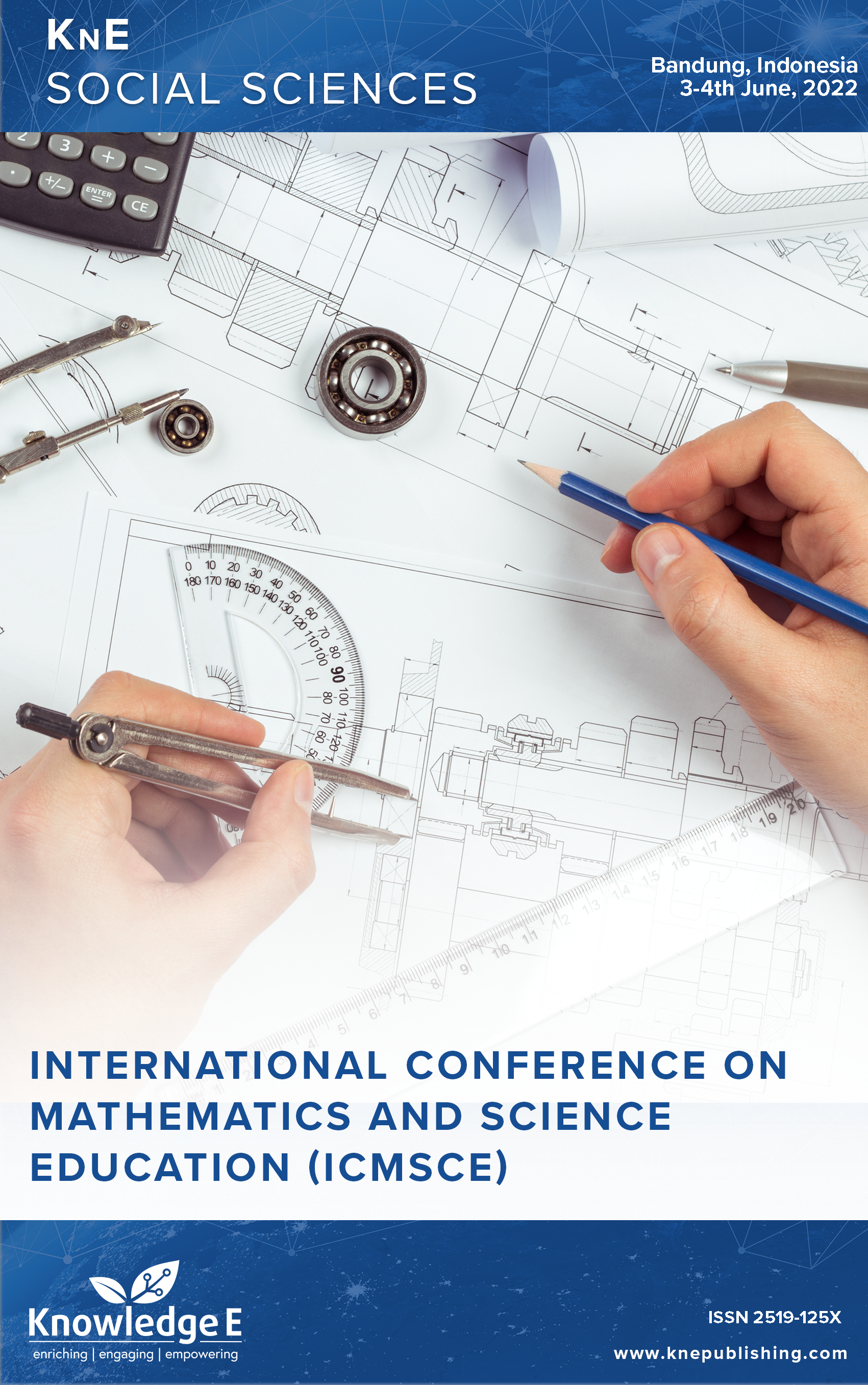Scientific Explanation Skills of Prospective Biology Teachers
DOI:
https://doi.org/10.18502/kss.v9i13.15908Abstract
This article investigated prospective biology teachers’ skills in compiling science explanations through writing and pictures to support their science explanations. This study involved 15 prospective biology teachers as the research sample. A test was constructed to measure their skills in writing science explanations. In this test, prospective biology teachers were asked to explain the concept of static electricity in living things. To analyze the data, we used the structure of a scientific explanation, which comprises three primary components: premise – accepted knowledge that provides the basis of the explanation, reasoning – logical sequences that follow from the premise, and outcome – the phenomenon to be explained. The reasoning component of the prospective biology teachers’ skills in presenting visual representations was poor. This finding supports the necessity of developing the skills of future biology teachers in writing science explanations.
Keywords: scientific, explanation skills, prospective teachers, biology
References
C. on C.F. for the N.K. 12 S. Education and standards, K-12 Science. National Research Council; 2012.
Nawani J, von Kotzebue L, Spangler M, Neuhaus BJ. Engaging students in constructing scientific explanations in biology classrooms: a lesson-design model. J Biol Educ. 2019;53(4):378–89. DOI: https://doi.org/10.1080/00219266.2018.1472131
Tang K. The pro instructional strategy in the construction of scientific explanations. Teaching science. 2015;61:vol. 61:14–21.
Erduran S, Ozdem Y, Park JY. Research trends on argumentation in science education: a journal content analysis from 1998–2014. Int J STEM Educ. 2015;2(1):5. DOI: https://doi.org/10.1186/s40594-015-0020-1
Oliveira DK, Justi R, Mendonça PC. The use of representations and argumentative and explanatory situations. Int J Sci Educ. 2015;37(9):1402–35. DOI: https://doi.org/10.1080/09500693.2015.1039095
Sampson VD, Enderle PJ, Grooms J, Witte S. Writing to learn by learning to write during the school science laboratory: helping middle and high school students develop argumentative writing skills as they learn core ideas. Sci Educ. 2013;97:643– 70. DOI: https://doi.org/10.1002/sce.21069
OECD. Pisa 2015 draft science framework. Paris; 2013.
Wang CY. Scaffolding middle school students’ construction of scientific explanations: comparing a cognitive versus a metacognitive evaluation approach. Int J Sci Educ. 2015;37(2):237–71. DOI: https://doi.org/10.1080/09500693.2014.979378
Yeo J, Gilbert JK. Constructing a scientific explanation - a narrative account. Int J Sci Educ. 2014;36(11):1902–35. DOI: https://doi.org/10.1080/09500693.2014.880527
Zacharia ZC. The impact of interactive computer simulations on the nature and quality of postgraduate science teachers’ explanations in physics. Int J Sci Educ. 2005;27(14):1741–67. DOI: https://doi.org/10.1080/09500690500239664
McNeill KL, Krajcik J. Scientific explanations: characterizing and evaluating the effects of teachers’ instructional practices on student learning. J Res Sci Teach. 2008;45(1):53–78. DOI: https://doi.org/10.1002/tea.20201
Sandoval WA. Conceptual and epistemic aspects of students’ scientific explanations. J Learn Sci. 2003;12(1):5–51. DOI: https://doi.org/10.1207/S15327809JLS1201_2
Sandoval WA, Millwood KA. The quality of students’ use of evidence in written scientific explanations. Cogn Instr. 2005;23(1):23–55. DOI: https://doi.org/10.1207/s1532690xci2301_2
Aldresti F, Rahayu S, Fajaroh F. The influence of inquiry-based chemistry learning with the context of sociosaintific issues on high school students ’ the influence of inquiry-based chemistry learning. Jurnal Pengajaran MIPA. 2018;23(2):139–46. DOI: https://doi.org/10.18269/jpmipa.v23i2.12413
Thien LM, Razak NA, Keeves JP, Gusti I, Darmawan N. What can pisa 2012 data tell us? what can pisa 2012 data tell us? performance and challenges in five participating southeast asian countries. Sense Publisher; 2012.
Alfiraida S. Identifikasi Materi biologi SMA sulit menurut pandangan siswa dan guru sma se-kota Salatiga. J Biol Educ. 2018;1(2):209. DOI: https://doi.org/10.21043/jobe.v1i2.4118
Fensham PJ. Real world contexts in PISA science: implications for context-based science education. J Res Sci Teach. 2009;46(8):884–96. DOI: https://doi.org/10.1002/tea.20334
Brigandt I. Why the difference between explanation and argument matters to science education. Sci Educ. 2016;25(3):251–75. DOI: https://doi.org/10.1007/s11191-016-9826-6
Braaten M, Windschitl M. Working toward a stronger conceptualization of scientific explanation for science education. Sci Educ. 2011;95(4):639–69. DOI: https://doi.org/10.1002/sce.20449
Rahayu S. Promoting the 21st century scientific literacy skills through innovative chemistry instruction. AIP Conf Proc. 2017;1911(1):20025. DOI: https://doi.org/10.1063/1.5016018
OECD. PISA 2018 Assessment and Analytical Framework. Paris: OECD Publishing; 2019.
Fadilah M, Permanasari A, Riandi R, Maryani E. Analisis karakteristik kemampuan literasi sains konteks bencana gempa bumi mahasiswa pendidikan ipa pada domain pengetahuan prosedural dan epistemik. Jurnal IPA & Pembelajaran IPA. 2020;4(1):103–19. DOI: https://doi.org/10.24815/jipi.v4i1.16651
Ainsworth S. The functions of multiple representations. Comput Educ. 1999;33(2):131–52. DOI: https://doi.org/10.1016/S0360-1315(99)00029-9
Tytler R, Prain V. A framework for re?thinking learning in science from recent cognitive science perspectives. Int J Sci Educ. 2010;32(15):2055–78. DOI: https://doi.org/10.1080/09500690903334849
Kementerian Pendidikan dan Kebudayaan, Silabus Biologi SMA/MA. Jakarta; 2020.
Reece JB. Campbell biology. New York, NY, USA: Pearson; 2011.
Lemke J. Multiplying meaning: visual and verbal semiotics in scientific text. Reading Science: Critical and Functional Perspectives on Discourses of Science. 2005;(February):87–113.
Creswell JW. Educational research: planning, conducting, and evaluating quantitative and qualitative research. Boston: Pearson; 2021.
Purwanto N. Prinsip-prinsip dan teknik evaluasi pengajaran. Bandung: Remaja Rosdakarya; 2003.
Handayani W, Setiawan W, Sinaga P, Suhandi A. Triple step writing strategy: meningkatkan keterampilan menulis materi ajar multimodus representasi pada mahasiswa calon guru fisika. Jurnal Inovasi Pendidikan IPA. 2021;7(1):46–60. DOI: https://doi.org/10.21831/jipi.v7i1.37781
Eilam B, Poyas Y, Hashimshoni R. Representing visually: what teachers know and what they prefer. In: Eilam B, Gilbert JK, editors. Science teachers’ use of visual representations. Cham: Springer International Publishing; 2014. pp. 53–83. DOI: https://doi.org/10.1007/978-3-319-06526-7_3
Mayer RE, Moreno R. Nine ways to reduce cognitive load in multimedia learning. Educ Psychol. 2003;38(1):43–52. DOI: https://doi.org/10.1207/S15326985EP3801_6
Education OF. Visualization in science education : the results of pilot research in grade 10. 2009;16.
Locatelli SW, Ferreira C, Arroio A. Metavisualization: an important skill in the learning chemistry. 2010.
Budiman I, Yanto ES. Analisis eksplanasi ilmiah listrik stastis siswa SMP dari perspektif bahasa dalam pengembangan literasi sains. Prosiding Seminar Nasional Fisika; 2017. pp. 144–9.
Treagust D, Harrison A. The genesis of effective scientific explanations for the classroom. 1999.

